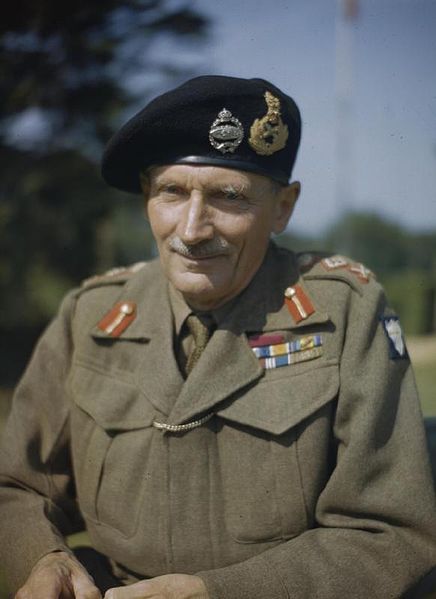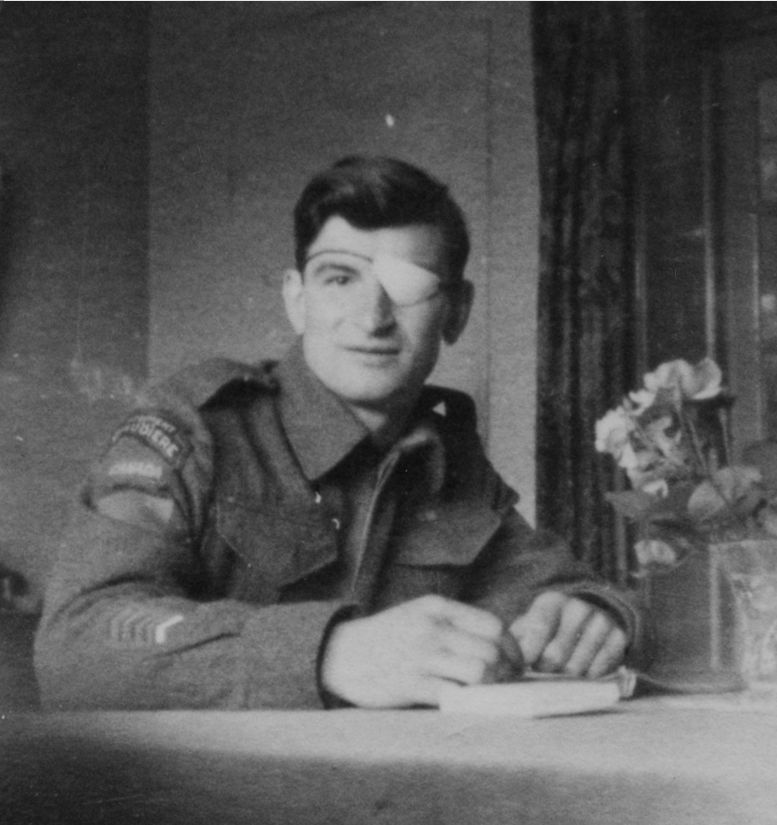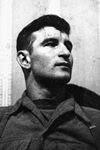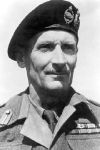Along the Crowded Roads of War
Last Impressions of My Visit to the Western Front
By Captain Norman MacMillan, M.C., A.F.C.
The War Illustrated, Volume 9, No. 208, Page 69-70, June 8, 1945.
In this, the last article of this series, I will describe briefly some of the many things I saw for which there is no space to give a full description. Follow me in imagination on long journeys across Germany, Holland, Belgium and France, along the crowded roads.
One of the few forward cemeteries I saw was just outside Nijmegen, beside a country lane bordered with elms, whose sandy surface led to the gated entrance to a wood: a quiet spot. Six graves were in a single row in a wired-off rectangle of ground. A large central cross stood higher than the humbler wooden crosses that marked the burial place of each man. I noted the names. Almost all were of men of different regiments. If any of their relatives should read these lines, they may be glad to know that the cemetery was well kept. These were the inscriptions on the crosses:
5506369 Pte. Pease, E. A., The Hampshire Regt.
4862780 Pte. Mellors, W., Leicester Regt. 11/10/44.
5504337 Pte. Newton, S. N., The Hampshire Regt. 11/10/44.
6406521 L/Cpl. Ashdown, H., C.M. Police. K/A. 12 Oct., 1944.
1231054 W/O Wilks, R.A.F., 11/10/44.
1144509 Gnr. Oades, F. Born Sept. 10, 1920. Killed in Action, 25 Oct., 1944. C. of E.
A long column of German prisoners of war trudged along a lane, their boots squelching in the mud. There were about a thousand of these disconsolate-looking men in mud-bedrabbled greatcoats and uniforms, their windy pride deflated, their future dim, but not, like that of some of their foes and comrades, extinguished. We drove on to visit an Army Air Observation Post. Here half the personnel were Army and half R.A.F. The soldiers ran the transport, the R.A.F. flight mechanics services the Auster aeroplanes. The squadron had 19 officers and 16 aeroplanes. All the pilots were gunner officers. Their Austers were unarmed. They generally flew between 800 and 4,000 feet, and came down to land if they saw enemy aircraft below 10,000 feet. They relied on the R.A.AF. fighter screen shooting the enemy out of the sky. Flak was another matter.
The Auster is simply an elevated artillery observation post from which the plan view of the target enlarged the vision obtainable by the surface forward observation officers. Sometimes the air view is superior to the ground view, sometimes it is the other way about, and sometimes the air view is the only one. Both views are needed for modern artillery fire, and both posts must be manned by gunner officers. The Austers carry radio telephones, and cameras when tactical photographs are required.
Dead Were Used to Kill the Living
The day before my visit five Messerschmitt 109s swooped down on this airfield and shot up a visiting Auster that was about to alight. The pilot was killed. In the plane were Major J. R. E. Harden and Captain D. C. M. Mather. The pilot fell over the controls. Mather was wounded. Harden had never piloted a plane, but he leant forward, pulled the pilot's body away from the controls, seized the stick and got down without a catastrophic crash, in which he received slight head injuries and Mather broke an arm.
A few dead Germans lay huddled in slit trenches concealed between the houses of Riethorst village, untouched because their bodies had not been examined for booby traps. An ugly war in which the dead were used to kill the living! The village street was strewn with rubble and rubbish of all kinds. A petrol pump lay on its side. A private motor-car lay upside down upon a bank beside the Bondshotel. German hand grenades still lay about the slit trenches. A dead German soldier lay in the gutter like a dead dog. More corpses lay in the fields, which were not yet cleared of mines; one British soldier was blown up and badly wounded when crossing over to two German soldiers' bodies. About 50 Germans still held out in a factory behind us to the right. Ahead they were in strength. Somewhere in between there was an indeterminate line.
The retreating enemy blew up the bridge across the stream at the end of the village. During the night the Royal Engineers were unable to build a new bridge because of snipers. When daylight came the snipers were dealt with. A wooden bridge was built and single line traffic got across. They were now making a wider and stronger crossing. They had laid a corrugated iron culvert in the stream bed beside the bridge to carry the water. Bulldozers were nosing it over, with soil and rubble of demolished buildings, to make a road. When that was done the bridge would come down, for use elsewhere, and that part of the stream by similarly treated to widen the road. It was dangerous work; three engineers were killed by mines while building the bridge. But no British casualties were to be seen. All had been borne back. Only the booby-trapped Germans lay about, and they, too, would soon be removed beyond sight if not memory.
A dog platoon cleared the mines at Riethorst. They had been trained at the Dog School, north of London, after having been given to the Service by their owners. The dogs were in the charge of Sappers dressed in anti-gas coat, rubber boots and steel helmet. Those I met were gamekeepers in civil life.
Laddie was worked by Sapper Wilfred Crick, of Cambridgeshire, keeper to the late Earl of Ellesmere; he had transferred to this job from the Ack-Ack. Bruce jumped up excitedly at Sapper Robert Coote, another Cambridgeshire gamekeeper, who had a tin mug tied to his belt with enticing pieces of dog foot to be given as reward for good work. Evidently Bruce though he had done good work already. In charge of the platoon of dogs was Sergeant Terence Maguire, who was a coal miner in County Durham before war turned him into a sapper.
Roads of tracks cleared of mines were marked out with white tape – which probably explains the British housewife's shortage of this material. While the dogs worked eastwards, in Riethorst were notices: ROAD VERGES NOT CLEARED OF MINES, and outside the houses were other placards: HOUSES NOT CLEARED OF BOOBY TRAPS. But due to the skill of both men and dogs there have been comparatively few casualties in the dog platoons.
In Holland and Belgium I frequently found myself in flying bomb alleys. Frequency varied. Some days there were many, other days few bombs. Sometimes they came over at the rate of about six an hour. Their height seemed to vary between 1,200 and 3,000 feet. I also spent some time at various receiving ends, where I found that the use of V1 and V2 weapons against the Allies on the Continent was almost inconsequential in its effect upon the military effort. It did not hold up the work of the great port of Antwerp, where I saw many ships discharging their military cargoes, although it drove many of the civilian inhabitants out of the city and caused superficial damage to housing, and here and there destruction.
Antwerp was as quiet as Brussels was busy. If, as at least once did happen, an oil store was hit, Messerschmitt 262 jet-planes flew over and photographed the result; but the quantity of oil lost was so small that no hold-up was involved in the supply of either road transport or high octane aviation petrol. If, occasionally, billets were hit, other billets could be found. The V-weapons were, at their then stage of development, merely a nuisance.
Ack-Ack batteries were stationed on the line of flight of the flying bombs and brought down not a few of them. On a dripping wet Flanders day I visited No. 484 Battery. Regimental H.Q. Mess was in the château of a Belgian baron, whose rooms had old wood panelling and massive Flemish furniture. Senior Commander Elizabeth Elwes, second cousin of Simon Elwes, the portrait painter, greeted us, and we drove over to a gunsite, where slippery duckboards kept one's feet off the muddy soil. Four 3.7-in. guns sited in the field were shrouded in waterproof covers. Nearer were the predictor, radiolocation posts, and Nissen huts.
This was the first mixed battery to cross the Channel. There were 500 men and 800 girls in the regiment. There were 70 men and 120 girls in a section. The section I met was commanded by Captain L. Povey, who was a Mayfair ladies' hairdresser before the war. With a charming smile he said he thought that was why he could handle the girls so well. It certainly seemed a happy unit. The A.T.S. did 24 hours on duty and 24 hours off. They were divided into four sections, one section manning, one on relief, one in bed, and one on fatigues and daily leave. Men manned the guns, the girls the predictor and signals. They had then shot down 19 flying bombs in Belgium. They classified their results as Category A, bomb blown up in flight; Category B, bomb brought down. “Smack on” was their slang for a direct hit.
The manning hut was made locally as an annexe to the Nissen control-room. Within it there were a round iron stove, eight beds, washstand, looking-glass, chairs – primitive but liveable. There was a constant supply of hot water from a tank heated by the exhaust pipe of the generator. Subalterns Jean Vernon and Susan Inglis told me they did one night's duty in every four. There were organized parties, and dances four to five miles away. They could get into Brussels by tram in slightly under two hours, and got 48 hours leave every month. But officers had to go alone, whereas the other ranks went sociably in parties of six. When the non-commissioned girls arrived in Brussels they went to the Montgomery Club for a hair-set manicure and lunch; then they would go on to a cinema and the Montgomery or A.E.F. Club for tea-dance; and in the evening find excellent entertainment at an E.N.S.A. theatre or the 21 Club.
In the manning hut, Corporal Dorothy Strain, of Chorley, said it was “a bit lonely when there were no doodle-bugs around”. Some of the girls wrote letters, some read, others talked, one brushed her long blonde hair before the glass. They were happy in spite of the depressing weather, and the inelegant hut which was like a contractor's workmen's shed. Cheerfullest among them was L/Cpl. Margery Cloud, nicknamed “Sunshine”. Dancing, oh yes, there were weekly dances at a café; “rat racing” they called it. Each girl could get two bottles of beer a month, but very few used it. Cosmetics were scarce; the Mess notice read, “Month's Allocation: strict rota will be drawn for”.
They were against conscription for girls for overseas service. “We volunteered, and we can rough it”, they said. “But a girl should not be forced to come out here and rough it like this if she does not want to.” Suddenly the siren sounded; instantly the girls were off at the double to their action stations, in the rain, out in the muddy field, or in the control-room – without fuss or excitement.
The girls of this battery composed their own songs. And here are verses from two of them:
Oh! Merry oh! Merry oh! merry are we.
We are the girls of the Artillery;
Sing high, sign low, wherever you go,
The girls of the Ack-Ack they never say no.
Down in buzz bomb alley,
You'll find us every night,
Shooting down the buzz bombs
Is surely our delight.
Every night you'll find us standing there,
We curse and swear: but we don't care.
Down in buzz bomb alley, the Gunner's Paradise.
They were first-class soldiers, those Ack-Ack girls; but they were neither toughened nor roughened by their work for the Army.
Previous and next article from Seeing the War at First Hand
My Visit to Wartime Holland
Control of the waterways is so important in Holland that a Government minister of public works (Waterstaat) is responsible for this feature of Dutch life, and each district in Holland has its own wate
Index
Previous article
I Was There! - I Went With the Green Berets to Osnabruck
Senior Brigade Chaplain and R.C. Chaplain to the 1st Commando Brigade, the Rev. Terence Quinlan, R.N. (known throughout the Brigade as “The Bish”), tells how he stopped a sniper's bullet – and m
Next article
I Was There! - In the Nightmare City of Rangoon Today
The Burmese capital was reoccupied by British forces on May 3, 1945, after nearly three years' occupation by the Japanese. How the once lovely city had been transformed by the enemy to a horror almost







